Were Adam and Eve Africans ?
Consider the following two reports from BBC news, both written by the same author as he reviews the results of two different genetic studies. Note the differences.
| Wednesday, 6 December,
2000, 19:42 GMT
Genetic study roots humans in
Africa
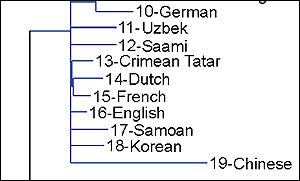 By BBC News Online science editor Dr David
Whitehouse
New evidence for the so-called Out of Africa hypothesis of modern humans suggests that our ancestors migrated from the continent about 50,000 years ago.
By looking at the individuals' shared, maternally inherited DNA sequences, together with a knowledge of how this genetic material changes over time, the scientists have been able to trace our common ancestry. As well as showing the evolutionary tree is firmly rooted in Africa, their study even suggests human numbers may have dwindled to just 40,000 at one stage. Rival theories There are two competing theories to explain how mankind spread across the globe. One suggests that between 100,000 and 200,000 years ago modern man (Homo sapiens) emerged from Africa to slowly populate the rest of the world, replacing any species of human that were already there. This is the Out of Africa hypothesis. The other theory suggests that modern humans arose simultaneously in Africa, Europe and Asia from one of our predecessors, Homo erectus, who left Africa about two million years ago. In recent years, support for the Out of Africa theory has come from the study of DNA in mitochondria, the energy-generating structures that reside just outside a cell's nucleus. This mtDNA, as it is known, is inherited only from females. It also mutates - errors appear - at a steady rate, meaning it can be used as a "molecular clock" to investigate human history. Deep branches Critics argued such analysis was based on a small section, about 7%, of the mtDNA and this might cause problems in determining the genetic distance between individuals. With the data available it was not possible to trace the mtDNA lineage back to sub-Saharan Africa, they argued. But the Swedish group have overcome some of the original shortcomings by carrying out an analysis of the complete mitochondrial genomes of their 53 subjects. The new analysis suggests the three deepest branches on the new mtDNA family tree all go back to sub-Saharan Africa and there is another branch that contains both African and non-African mtDNA. "This is the first study in which the genome is being used in a sufficiently large number of individuals to come up with very strong evidence, in this case supporting the Out of Africa theory," lead researcher Professor Ulf Gyllensten said. Sports stadia What seems particularly significant is that the amount of mtDNA diversity among Africans is more than twice as great as the diversity seen among non-Africans. The data also show some evidence of a "population bottleneck" when the number of humans fell to a low level. It happened about 40,000 years ago when there could have been as few as 40,000 humans - a number less than many national sports stadia would hold. The researchers may have also identified the stock of people from whom all non-Africans descended. They write in the journal Nature: "A group of six African (mtDNA) sequences are genetically distant to those of other Africans, but share a common ancestor with non-Africans. These lineages represent descendants of a population that evidently gave rise to all the non-African lineages." The researchers believe all humans alive today could share common ancestry with a being in Africa who lived about 120,000 to 220,000 years ago. (copied from http://news.bbc.co.uk/2/hi/science/nature/1058484.stm) |
Monday, 9 June,
2000, 19:42 GMT
When humans faced extinction
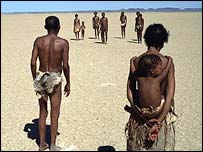 By BBC News Online science editor Dr David
Whitehouse The study suggests that at one point there may have been only 2,000 individuals alive as our species teetered on the brink. This means that, for a while, humanity was in a perilous state, vulnerable to disease, environmental disasters and conflict. If any of these factors had turned against us, we would not be here. The research also suggests that humans (Homo sapiens sapiens) made their first journey out of Africa as recently as 70,000 years ago. Little diversity Unlike our close genetic relatives - chimps - all humans have virtually identical DNA. In fact, one group of chimps can have more genetic diversity than all of the six billion humans alive today. It is thought we spilt from a common ancestor with chimps 5-6 million years ago, more than enough time for substantial genetic differences to develop. The absence of those differences suggests to some researchers that the human gene pool was reduced to a small size in the recent past, thereby wiping out genetic variation between current populations. Evidence for that view is published in the American Journal of Human Genetics. Oldest members Because all humans have virtually identical DNA, geneticists look for subtle differences between populations. One method involves looking at so-called microsatellites - short, repetitive segments of DNA that differ between populations. These microsatellites have a high mutation, or error, rate as they are passed from generation to generation, making them a useful tool to study when two populations diverged. Researchers from Stanford University, US, and the Russian Academy of Sciences compared 377 microsatellite markers in DNA collected from 52 regions around the world. Analysis revealed a close genetic kinship between two hunter-gatherer populations in sub-Saharan Africa - the Mbuti pygmies of the Congo Basin and the Khosian bushmen of Botswana. First migration The researchers believe that they are "the oldest branch of modern humans studied here". The data also reveals that the separation between the hunter-gatherer populations and farmers in Africa occurred between 70,000 and 140,000 years ago. Modern man's migration out of Africa would have occurred after this. An earlier genetic study - involving the Y chromosomes of more than 1,000 men from 21 populations - concluded that the first human migration from Africa may have occurred about 66,000 years ago. The small genetic diversity of modern humans indicates that at some stage during the last 100,000 years, the human population dwindled to a very low level. It was out of this small population, with its consequent limited genetic diversity, that today's humans descended. Small pool Estimates of how small the human population became vary but 2,000 is the figure suggested in the latest research. "This estimate does not preclude the presence of other populations of Homo sapiens sapiens (modern man) in Africa, although it suggests that they were probably isolated from each other genetically," they say. The authors of the study believe that contemporary worldwide populations descended from one or very few of these populations. If this is the case, humanity came very close to extinction. (copied from http://news.bbc.co.uk/2/hi/science/nature/2975862.stm) |
Out of Africa 50,000 or 70,000 years ago ??
Only 40,000 or 2,000 individuals were our ancestors ??
"Richard Klein, professor of anthropological sciences, in his book, The Dawn of Human Culture (John Wiley & Sons, April 2002), proposes a "new" theory for the latest stages of human evolution. "It's a nontestable hypothesis," Klein admits. "The book is about human evolution as I understand the record. My genetic explanation for the major behavioral change 50,000 years ago is the most plausible one, but I can't prove it." For Klein this neural mutation hypothesis is the most economical explanation of why anatomy and human behavior drifted apart. Fossilized skulls reveal little about the brain underneath. But a gene mutation may have changed critical neural processes such as speech and language.
The now widely accepted "Out-of-Africa-2" hypothesis is based on the appearance of anatomically and behaviorally modern humans on a small patch in Eastern Africa as recently as 50,000 years ago. All of a sudden these early modern humans developed a new repertoire of hunting skills, novel forms of social interaction and a sense of art. They became creative innovators expanding their mental and technical capabilities. These new achievements drove the early modern humans out of Africa to spread over Europe and Asia. Within a short period of only about 15,000 years they supplanted the Neanderthals in Europe and other nonmodern humans in other parts of the world.
The cause for the drastic change in behavior in the early modern
humans is unknown. But the most plausible explanation for the
success of modern humans is a sudden biological change.
Some of the new (and old) evidence is ambiguous, circumstantial, or even contradictory, but this is inevitable in historical science, which has more in common with a criminal trial than it does with a physics experiment." (examples, "Toumai, Monkey or man?" :Appendix A and "Georgian skull's link to our past" : Appendix B)
In his phylogeny on page 78 shown below we see many tentative dotted bars and also many
question marks! Note the many supposedly dead ended branches! AND:
Where is the LINK??
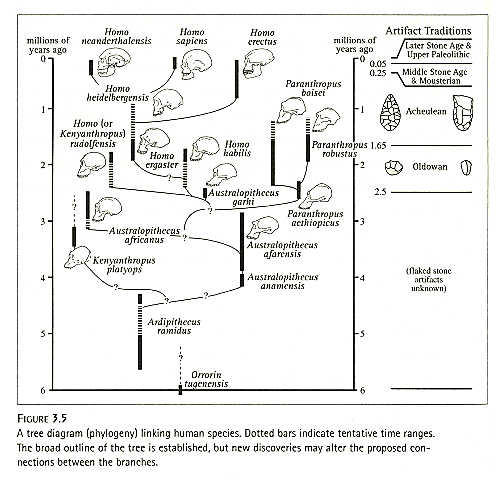
Then is this Adam and Eve, are they among the "out of Africa" group that appeared around 50,000 years ago ?
Problem: the Scriptures definitely tell of an Adam and Eve that lived in the "Garden of Eden" which was located somewhere near the Tigris and Euphrates rivers.
Then consider the following evidences!
"The great majority of the cultivated plants of the world trace their origin to Asia. Out of 640 important cultivated plants, about 500 originated in Southern Asia. In Asia alone we have established five of the principle regions of cultivated plants.... The fifth region of origin in Asia is the Southwestern Asiatic centre and includes Asia Minor, Trans-Caucasia, Iran and Western Turkmenistan. This region is remarkable, first of all, for its richness in numbers of species of wheat resistant to different diseases...There is no doubt that Armenia is the chief home of cultivated wheat. Asia Minor and Trans-Caucasia gave origin to rye which is represented here by a great number of varieties and species....
Our studies show definitely that Asia is not only the home of the majority of modern cultivated plants, but also of our chief domesticated animals such as the cow, the yak, the buffalo, sheep, goat, horse, and pig...The chief home of the cow and other cattle, the Oriental type of horse, the goat and the sheep is specifically Iran....
As the result of a brilliant work of Dr. Sinskaya, the discovery was recently made that the home of alfalfa, the world's most important forage crop, is located in Trans-Caucasia and Iran....
From all these definitely established facts the importance of Asia as the primary home of the greatest majority of cultivated plants and domesticated animals is quite clear."
The above quotes from the book by Vavilov, N. , "Asia: Source of Species" in Asia, February 1937, p. 113.
More recent studies conducted by Melinda A Zeder and Brian Hesse (Science 287 (2000) 2254-57) place the initial domestication of goats to the Zargos Mountains at about 10,000 years ago. And Manfred Heun's (Science 278 (1997) 1312-14) studies indicate that large scale wheat cultivation began from 8,000 to 9,000 years ago near the Karacadag Mountains. Both areas are very near where the Tigris and Euphrates Rivers come close together.
"The cradle of agriculture generally has been placed in the Jordan Valley of the
southern Levant (today's Israel and Jordan). But work by Simcha Lev-Yadun of
Israel's Agricultural Research Organization and colleagues suggest the first
farms may have been farther north, between the Tigris and Euphrates rivers in
what is today northeastern Turkey and northern Syria.
Wild progenitors of the main Neolithic founder crops (einkorn wheat, emmer wheat,
barley, lentil, pea, chickpea, bitter vetch, and flax) are found together only
in this small core area of the Fertile Crescent.
Lev-Yadun reports that wild chickpea especially is extremely rare, yet it was a
staple crop of Neolithic life 10,000 years ago. Agriculture, therefore, probably
began in an area where chickpea is native. Archaeological evidence shows that the
earliest known farming settlements of the Fertile Crescent were in this core area.
Also, the limited genetic variability of these crops implies that they were
domesticated only once — rather than by several different cultures at roughly
the same time. Evidence of domesticated crops in the core area dates to about
10,000 years ago, while the earliest signs of farming elsewhere are about 9,300
years ago.
Neolithic sites discovered in the core area indicate that a society with plenty
of food thrived there. In sites such as Cayonu, Novali Cori, and Gobekli Tepe,
impressive architecture, images, and artifacts have been found. Settlement sites
are also larger in this area than many others of the same time in other parts
of the Fertile Crescent. ..." (From "The Cradle of Agriculture? New Evidence
Moves the World's First Farmers into Turkey" by Reagan Duplisea,
http://www.discoveringarchaeology.com/ articles/ 060100-turkeyfarm.shtml)
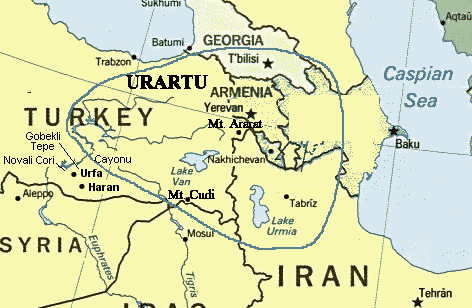
"It is known that agriculture spread from the Middle East to Europe during the Neolithic period about 12,000 years ago, but for many years archeologists have debated how this occurred. Was it due to the movement of people or to the movement of ideas? Previous genetic analysis of people living today suggests a migration - that the people moved - but critics have questioned this view. The latest study reinforces evidence of a migration in which people brought their ideas and lifestyle with them." (from http://www.sciencedaily.com/releases /2002/09/ 020911072622.htm)
Professor Klein and many others do not consider the evidences for the appearance of a group of intelligent farming and building humans sometime before 12,000 years ago in their analysis of human culture! Also considering Professor Klein's theoried "fortuitous mutation ... affected cognitive power rather than overall brain structure", could this be the first stages of the development of "accountability", the ability of humans to have a social conscience, the ability to understand the differences between right and wrong, which is so much a part of the Scriptual story of Adam and Eve, and which separates humans from the rest of the primates? This development which was finalized in the "Garden of Eden"! Also let us not forget the concept of "dominion". The humans of the "Garden of Eden" had the capability to dominate over all other living creatures on the earth, a capability fully demonstrated only by the migrants out of the 'Ararat" area as they developed their methods of farming, animal domestication and community building.
As per the Scriptures, these latter evidences indicate that the humans who demonstrated the highest level of intellect came from the area of "Ararat" and "Eden" and not from Africa. That Adam and Eve were farmers and not hunter/gatherers!

Appendix A:

from http://www.guardian.co.uk/uk_news/story/0,3604,808955,00.html
Palaeontologists are going to war over whether bones discovered in African desert are of an ape or a proto-human
James Meek, science correspondent
Thursday October 10, 2002
The Guardian
As he awoke on his last day on earth, it is unlikely Toumai thought about much more than how he would survive the following hour - let alone that, 7m years later, a bunch of ape-like creatures would be furiously discussing how much they resembled him.
Today, three months after the sensational announcement in Britain's leading scientific journal, Nature, that the oldest member of the human family had been found, the same journal publishes a sustained attack by rival scientists on the contention that Toumai's skull is, in fact, that of a hominid.
Few regions of science provoke more passion than the nature of the evolutionary journey from early ape-like mammals to homo sapiens, and other palaeontologists began grumbling about the sapience of the skull's French discoverer, Michel Brunet, as soon as his press release, with the bold claim "Toumai the Human Ancestor", hit the news media.
Today's attack on Professor Brunet and his colleagues in Nature - accompanied by a harshly worded rebuttal from Prof Brunet himself - ups the ante, putting doubts about whether the skull is hominid, ape, both or neither into the orthodox scientific arena.
Much is at stake - science, individual reputations, careers, research grants. Beneath this clash, however, lies the deeper and more disturbing question about when humans end and non-humans begin.
The skull was found in the Djurab desert of northern Chad by a team led by Prof Brunet of the University of Poitiers, who said at the time that it had been the culmination of 25 years' searching.
Prof Brunet, backed by independent scientists, claimed that the skull and jaw fragments provided enough evidence to show that we were looking into the face of the earliest hominid ever discovered.
The excitement around the discovery - it was proclaimed "a turning point", "a small nuclear bomb", and "the most important fossil discovery in living memory" - came because the skull's age put it in the middle of a 5m-year gap in our knowledge, between the accepted ancient apes and the accepted ancient hominids.
Today, another group of scientists, two based in France, two in the US, present a point-by-point demolition of Prof Brunet's case, arguing that there is no evidence to suggest Toumai was a hominid. "We believe [Toumai] was an ape," they conclude.
Prof Brunet's defenders point out that two of the authors of the critique, Brigitte Senut of France's National Museum of Natural History and Martin Pickford of the College of France, are direct rivals, having discovered their own candidate for oldest hominid in Kenya two years ago.
But another member of the anti-Brunet camp, John Hawks of the University of Wisconsin in Madison, pointed out that he had no axe to grind.
"There are social benefits that come from having the earliest hominids," he admitted. "You get your grants renewed, and the world at your door. I don't have a lot invested in it myself. My co-authors do, but I am not out digging these things up. I just read something I didn't find convincing."
Mr Hawks and his colleagues do not dispute the age of the fossil, or even its importance, but argue there is not enough evidence to put it in on the human side of the primate family tree, and much to link it with gorillas or chimpanzees.
Toumai's teeth have at least as much in common with early apes as they do with hominids, they say. Features like the large brow ridge are indeed seen in relatively recent human ancestors, but not in earlier, known hominids - meaning the brow would have to have evolved one way, then back, then evolved again to get into the human family.
Even with only part of a head to go on, critics say, the balance of evidence suggests the creature could not walk upright.
"The evidence they present is not conclusive, but there's conclusive evidence that it's not a biped, and therefore we conclude it's not a hominid," said Milford Wolpoff, of the University of Michigan in Ann Arbor, the fourth member of the anti-Brunet group. "We think it's an ape. I suppose it could be a female gorilla. To be honest, I think it could be an ancestor of both chimps and humans before the species split, and probably this is an extinct branch."
Dr Wolpoff stressed he was not taking issue with the momentous nature of the find, only the conclusions Prof Brunet had drawn: "It's the only fossil ape we've got from between 10m years ago and today."
Prof Brunet could not be contacted for comment yesterday. In his rebuttal, he said his critics had misrepresented the dimensions of Toumai. "Wolpoff et al have described no derived ape feature of [Toumai], nor have they disproved any derived features that this species shares with later hominids."
Henry Gee, a senior editor at Nature, said that the journal had gone to enormous lengths to verify the original Brunet paper. He had visited Poitiers twice to see the skull, and the paper had been anonymously peer-reviewed by five independent scientists in the same field.
Both Prof Brunet and Dr Gee pointed out that in 1925, when Nature stunned the world with its publication of Raymond Dart's account of his discovery of a 3.3m-year-old hominid fossil in South Africa, critics said the skull was that of an ape.
Dr Gee said the critics made interesting points, but were, he felt, "barking up the wrong tree". "Whatever Toumai is, it shows a combination of features we haven't seen before in hominids or apes," he said.
Professor Chris Stringer, head of human origins at the Natural History Museum in London, was more cautious, pointing to growing evidence that human evolution was "bushy" rather than linear.
"It is premature to push the claims too far for any existing fossils to represent the earliest members of the human family in the present patchy state of our knowledge," he said.
Large, continuous brow ridge
· Supporters of the hominid theory say this suggests a link to more recent human ancestors. Critics point out that known early hominids, younger than Toumai, didn't have the ridge. The same is true of the creature's vertical face: could these features have evolved, de-evolved, then re-evolved?
Spine-skull intersection
· Some critics say the hole where the spine enters the skull is too far forward for Toumai to have walked upright. Supporters of the hominid theory say this cannot be known
Thickened enamel on molars
· Critics say this feature means Toumai was as likely to have been an ape ancestor - or an evolutionary dead end - as a hominid ancestor
Canine teeth
· Critics say the ratio of the distance between Toumai's canine teeth and from the canines to the back of the mouth are as chimp-like as they are hominid-like, and prove nothing
Appendix B:

Georgian skull's link to our past
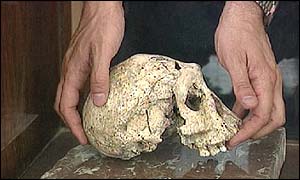
The moment is indelibly burned into Dato Zhvania's memory.
It had been a day like any other - a day of back-breaking, painstakingly meticulous work. A day of throbbing, enervating heat.
But as he sifted gingerly through the baked patch of ground before him, his fingers touched something different.

The team celebrates their
find |
The archaeological site at the medieval town of Dmanisi, 80 kilometres (50 miles) south-west of the Georgian capital, Tbilisi, had already revealed some of its secrets.
Perhaps, just perhaps, this was his turn.
But what emerged as he brushed away the earth was to far exceed his expectations.
He did not know it yet, but in his hands he held the almost perfectly preserved skull of the most ancient human being ever found in Europe - 1.8 million years old.
More extraordinary still, it was about to throw into question all accepted theories about the migration of our ancestors out of Africa.
Dato could not contain his excitement.
A message was sent out to team leader, Davit Lortkipanidze, a paleoanthropologist at the Georgian State Museum in Tbilisi.
The media were alerted and Dato and his colleagues prepared to celebrate.
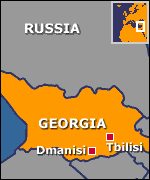 |
He shakes his head and smiles to himself at the memory.
We were standing at the spot where the skull had been found, deep beneath the foundations of the medieval town.
"And you know," he said, "this site is so big and so important that what we've found so far could be nothing compared with what still lies beneath the ground."
Ape-like
The remains of seven individuals have been found at Dmanisi - the most recent this summer - but what made this discovery so special was that it did not look like the skull of any human ever found outside Africa before.
Its brain cavity was far smaller - half the size of a modern human - and it had the huge canine teeth and thin brow of an ape.
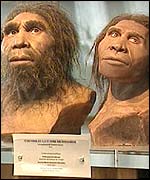
The skull variation may force us to rethink the
definition Homo |
This guy was short, long-armed and probably trailed his knuckles along the ground.
Not only that, the tools found around him were basic choppers and cutters, just like those found at the sites of early, primitive men in Africa.
Dato Lortkipanidze thought he recognised Homo habilis, a hominid with a close resemblance to an ape.
But what was he doing in Georgia? The theory had always been that the migration out of Africa had only happened with the evolution of big brains and the development of the tools and hunting skills to make the exodus possible.
|
Early humans |
|
Homo habilis: The first species in the
genus Homo, dating back 1.9 million years, and found only in
Africa
Homo erectus: The first species in the
genus Homo to leave
Africa |
Another unusual aspect of the Dmanisi find is that it was discovered in the same layer of sediment as other hominids with substantially larger brains - Homo erectus.
Mr Lortkipanidze suggests the variation may force us to rethink the definition Homo.
Land of origins
The old town of Dmanisi sits atop a promontory formed by the confluence of the Mashavera and Pinezauri rivers.
Today, it is a picnic spot for visitors from Tbilisi who come to see the ruins of the early medieval church and castle.

Dmanisi was once an important stopping point on
the Silk Route |
When I stood on the battlements above the church, I could easily make out the road the camels used to take and the steam baths once used by the traders.
It is a place of steep slopes and whispering winds, of forests and basalt cliffs, but to the north a plateau of cultivated fields stretches away to the horizon.
This was once savannah - home to rhinoceros, game and sabre-tooth tigers. Perfect hunting ground for hungry hominids.
Gazing out across this scene 1.8 million years after our ancestors stumbled out of Africa, I spotted a group of Georgian villagers cheering on a wrestling match amidst the ruins - a reminder that strife has been the defining characteristic of our existence ever since.
But for Europeans, Dmanisi is a reminder of something else too.
This, it seems, is where our history began. Dmanisi recalls our common origins.
Robert Parsons reported from Dmanisi for Europe Direct, which can be seen on BBC News 24 on 11 January at 1130 GMT, and on 12 January at 0230 GMT and 1430 GMT. The programme can also be seen on BBC World on 15 January at 2230 GMT, on 16 January at 0230 GMT, 0930 GMT and 1730 GMT, on 18 January at 1630 GMT and 2330 GMT, and on 19 January at 0230 GMT and 1930 GMT.

